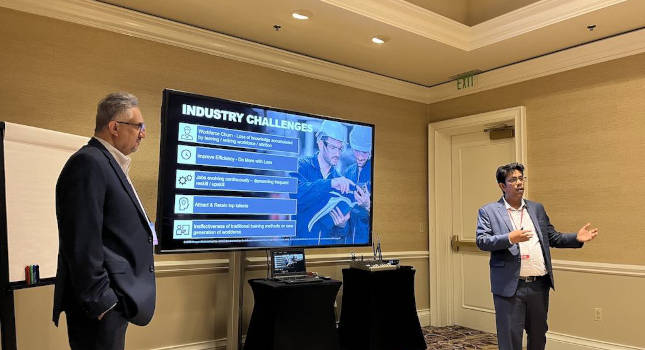Using advanced technology to help workers learn
Younger workers don’t learn the same way as older peers, which can make the knowledge transition difficult. Programs that leverage virtual reality (VR) and provide hands-on development are helping narrow the gap.
Workforce development insights
- Younger workers don’t learn through the manual like older workers and are more adept at learning through search engines and by doing.
- Honeywell’s Workforce 360 is designed to gamify the learning process and give engineers a safe virtual environment to learn by doing, reducing the time it takes to be competent from 2 to 3 years to around 6 to 8 months.
多是由technology better and more efficient, but the worker shouldn’t be forgotten in the development process.
“How do we improve human reliability to ensure the workplace is safe while providing optimum production?” asked Manas Dutta, general manager for workforce excellence growth initiative at Honeywell in his presentation “Advancing today’s workforce through digital twins, AI and VR,” with Ziad Kaakani, chief technology officer at HPS Lifecycle Solutions & Services at Honeywell. Dutta and Kaakani were among presenters at the 2023 Honeywell Users Group.
Five workforce challenges manufacturers face
The skills gap is nothing new, but this is compounded with a general talent drain. Many workers today are not prepared for the job they are asked to do. Making the human worker better, Dutta said, is an industry challenge for several reasons:
Workforce churn.Loss of knowledge accumulated with people leaving or retiring, which creates attrition.
Improving efficiency.Companies are asked to do more with less, and that’s not easy if they’re not properly trained.
Jobs are evolving.The nature of the jobs and their requirements are often changing and demanding frequent upskill and reskilling.
Trying to attract and retain top talent.Younger workers don’t stay as long as their older workers, which can lead to knowledge and experience gaps.
Worker training.Traditional training methods such as giving an engineer a manual and expecting them to learn like older workers did is ineffective.
“The industrial sector is behind 20 to 30 years of adopting digital transformation and training,” Dutta said. “They do classroom lectures, and new workers don’t like it. They learn completely differently.”

Ziad Kaakani (left) and Manas Dutta (right) during the “Advancing today’s workforce through digital twins, AI and VR” presentation at Honeywell Users Group (HUG) in Orlando. Courtesy: Chris Vavra, CFE Media and Technology
Evaluate, train and develop workers with advanced technology
Dutta describedHoneywell’s approach with their Workforce 360 product, which emphasizes providing the worker a digital environment to learn. The digital environment tools can help speed up learning by emphasizing four key targets:
Evaluate.The program gathers the worker’s skills through assessment tools to determine their operational performance.
Train.The workforce is trained through the digital platform.
Predict.The worker can then plan jobs through predictive insights.
Assist.They can prepare and execute tasks with on-the-job assistance in case there are challenges that aren’t covered in the lesson plan. Dutta said they cover about 70 to 80% of what a worker will see in the facility.
Dutta said gamifying the process lets workers learn everything without being exposed to dangerous conditions.
“If you do it for real,” Dutta said, “they might make a mistake during their training that can create a serious problem for the facility and the worker. Virtual, hands-on training lets them learn faster without being exposed to hazardous conditions. Instead of taking two to three years to be considered competent at your job, virtual training can knock it down to anywhere from six to eight months.”

The digital environment tools can help speed up learning by emphasizing four key targets: Evaluate, train, predict and assist. Courtesy: Chris Vavra, CFE Media and Technology
Customizing the workforce program, replicating the plant
While a general program is set for the customer, it is designed to be customizable for any facility that might use it.
“The customer can customize the lessons,” Kaakani said. “It’s a continuous evaluation and the user gets a replica of the plant. It’s an environmental digital twin.”
The environmental digital twin is often done with a 3D computer-aided design (CAD) drawing that provides a mostly-accurate view of the plan. Dutta said it ranges from 80 to 90%. From there, photos are often taken of the spots that are missing to give the user an immersive look at the facility that can be done through virtual reality (VR) or on a laptop.
“Technology like this is enabling the workforce to do the job right the first time and every time,” Dutta said.
Chris Vavra, web content manager, CFE Media and Technology,cvavra@cfemedia.com.
Do you have experience and expertise with the topics mentioned in this content? You should consider contributing to our CFE Media editorial team and getting the recognition you and your company deserve. Clickhereto start this process.




